The 50 Greatest Players in New York Giants Football History
The 50 Greatest Players in New York Giants Football History
Robert W. Cohen
ROWMAN & LITTLEFIELD
Lanham Boulder New York Toronto Plymouth, UK
Published by Rowman & Littlefield
4501 Forbes Boulevard, Suite 200, Lanham, Maryland 20706
www.rowman.com
10 Thornbury Road, Plymouth PL6 7PP, United Kingdom
Copyright 2014 by Rowman & Littlefield
All rights reserved . No part of this book may be reproduced in any form or by any electronic or mechanical means, including information storage and retrieval systems, without written permission from the publisher, except by a reviewer who may quote passages in a review.
British Library Cataloguing in Publication Information Available
Library of Congress Cataloging-in-Publication Data
Cohen, Robert W.
The 50 greatest players in New York Giants football history / Robert W. Cohen.
pages cm
Includes bibliographical references and index.
ISBN 978-1-4422-3631-8 (hardcover : alk. paper) ISBN 978-1-4422-3632-5 (ebook)
1. New York Giants (Football team)Biography. 2. Football playersRating ofUnited States. I. Title. II. Title: Fifty greatest players in New York Giants football history.
GV956.N4C64 2014
796.33264097471dc23
2014008848
 The paper used in this publication meets the minimum requirements of American National Standard for Information SciencesPermanence of Paper for Printed Library Materials, ANSI/NISO Z39.48-1992. Printed in the United States of America.
The paper used in this publication meets the minimum requirements of American National Standard for Information SciencesPermanence of Paper for Printed Library Materials, ANSI/NISO Z39.48-1992. Printed in the United States of America.
This book is dedicated to those longtime Giants fans who, like me, persevered through the dark period that lasted from 1964 to 1980, during which time the team posted a winning record just twice.
Acknowledgments
I wish to thank Richard Albersheim of Albersheims.com, Joseph Umphlett of SportsMemorabilia.com, George Kitrinos, Mike Morbeck, and Rick Sparacino, each of whom supplied me with several photos included in this book.
I would also like to express my appreciation to Erica Wines, Scott Mecum, John J. Shelmet, and Michael Cassella for contributing to the photographic content of this work.
Introduction
The Giant Tradition of Winning
The New York Giants , one of the National Football Leagues flagship franchises, first came into existence in 1925, when bookmaker (a legal profession at the time), raconteur, and sportsman Timothy J. Mara paid NFL president Joe Carr the $2,500 entrance fee that made him sole owner of New Yorks first representative in the infant circuit. Merely five years old at the time, the NFL, which spent most of its formative years operating in the shadows of baseball, boxing, and college football, knew that it needed to place a successful franchise in a large market such as New York if it had any hope of surviving. Although the Giants struggledalong with every other team in the leagueto make ends meet throughout the first decade of their existence, they nevertheless managed to win their first NFL title in just their third season, compiling a record of 1111 in 1927 that earned them recognition as league champion. (The NFL did not institute a playoff system until 1933.)
The stability of the National Football League became even more tenuous following the stock market crash of 1929, when the nation entered the Great Depression. Having suffered substantial losses that threatened the existence of the Giants, Tim Mara eventually handed over control of the franchise to his two sons, Jack and Wellington, only 22 and 14 years of age, respectively, when they assumed significant roles in the front office. However, before entrusting the team to his offspring, the elder Mara named Steve Owen the Giants coach in 1931. Owen, a huge lineman who remained active as a player his first two years at the helm, continued to coach the Giants until 1953, leading them to eight Eastern Division titles and two NFL championships.
The Giants captured the first of those championships in 1934 when they defeated the Chicago Bears by a score of 3013, just one year after losing to them in the title game by a score of 2321. In what eventually became known as the Sneakers Game, the Giants overcame George Halass powerful Monsters of the Midway by simply outsmarting them. Trailing Chicago by a score of 103 at halftime, the Giants combatted New Yorks Polo Grounds icy surface (game-time temperature stood at only 9 degrees) by exchanging their football cleats for basketball shoes. Able to find better footing than their physically superior counterparts, the Giants subsequently scored 27 unanswered points in the second half, romping to a 3013 victory in the process.
The Giants returned to the title game six more times under Owen, capturing their only other championship with him at the helm in 1938, when they defeated the Green Bay Packers 2317. One of the leagues most successful franchises from 1933 to 1944, the Giants posted a combined record of 89399 over that 12-year stretch. Although many other outstanding playerssuch as quarterback Ed Danowski, running back Tuffy Leemans, end Ray Flaherty, and the extremely versatile Ward Cuffgraced the teams roster at different times during that period, lineman Mel Hein remained the one constant, serving as a rock on both sides of the ball. Anchoring the offense from his center position, while also leading the defense from his linebacking spot, Hein established himself as the Giants first truly great player, eventually earning Hall of Fame honors with his superb two-way play.
New York struggled somewhat during the latter portion of the 1940s, posting a winning record just once between 1945 and 1949. However, with the development of young defensive back Emlen Tunnell into the teams next great player and the arrival of brilliant defensive mind Tom Landry, who helped Owen install the famed umbrella defense in 1950, the Giants once again became one of the NFLs most formidable squads, posting a combined record of 269 from 1950 to 1952. Nevertheless, New Yorks 39 finish in 1953 convinced team management that changes in the game such as the split-T formation, the man-in-motion, and the option play had caused Owens down in the dirt coaching philosophy to become outdated. Choosing to end its long association with Owen, ownership subsequently elected to replace him as head coach with former assistant Jim Lee Howell prior to the start of the 1954 season.
The hiring of Howell ushered in the next era of greatness for the Giants, who, after finishing a combined 1310 in their first two seasons under their new head coach, went on to appear in six out of the next eight NFL championship games, winning the title in 1956. Much of the success New York experienced during that time had a great deal to do with the exceptional abilities of the members of their coaching staff. While Tom Landry devised intricate defensive schemes to thwart opposing offenses, Vince Lombardi did a superb job of coaching the offense. Even after both men left to accept head coaching jobs with other teams and Howell announced his retirement at the conclusion of the 1960 campaign, the Giants continued to thrive under Howells replacement, Allie Sherman, who took over the top spot after previously doing an expert job of coaching the offensive backfield.
Also key to New Yorks success throughout the period was the level of talent the team fielded on both sides of the ball, particularly on the defensive end. The Giants front four of Andy Robustelli, Dick Modzelewski, Rosey Grier, and Jim Katcavage proved to be as dominant as any in the league. Sam Huff established himself as one of the circuits top linebackers. Meanwhile, Emlen Tunnell, Jimmy Patton, Dick Lynch, and Erich Barnes starred in the secondary.
Although not quite as formidable on offense, the Giants also had their fair share of weapons on that side of the ball. Wide receiver Kyle Rote, fullback Alex Webster, quarterback Charlie Conerly, and the versatile Frank Gifford gave the team talent at the skill positions, while perennial All-Pros Roosevelt Brown and Ray Wietecha provided excellent blocking up front. The offense became significantly more potent when veteran quarterback Y. A. Tittle and speedy wide receiver Del Shofner joined the team prior to the start of the 1961 campaign.
Next page
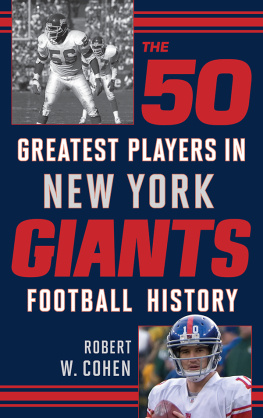
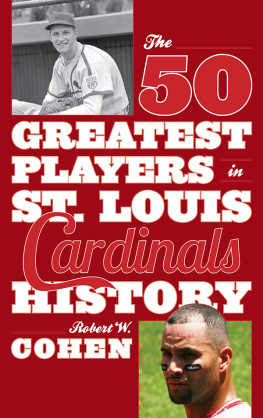
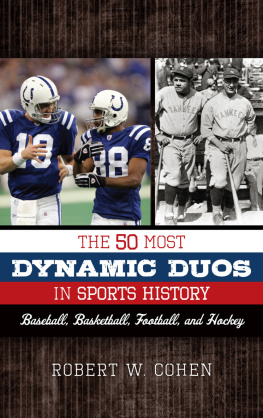


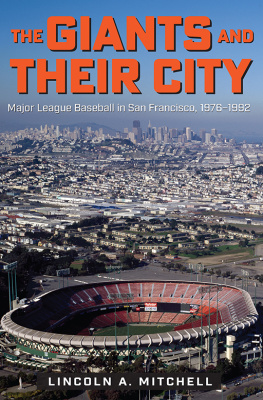
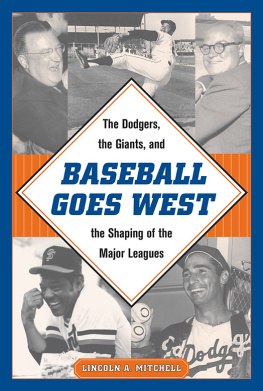
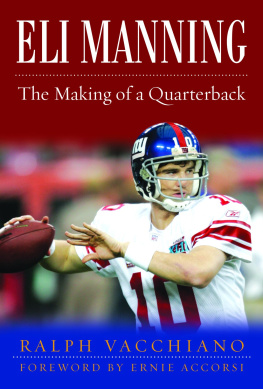
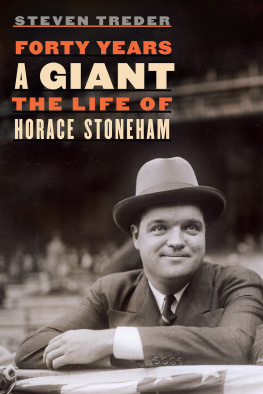
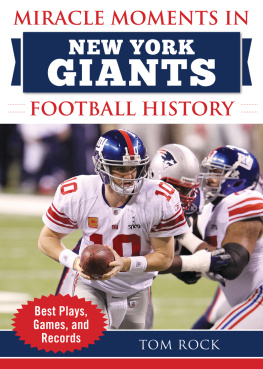
 The paper used in this publication meets the minimum requirements of American National Standard for Information SciencesPermanence of Paper for Printed Library Materials, ANSI/NISO Z39.48-1992. Printed in the United States of America.
The paper used in this publication meets the minimum requirements of American National Standard for Information SciencesPermanence of Paper for Printed Library Materials, ANSI/NISO Z39.48-1992. Printed in the United States of America.